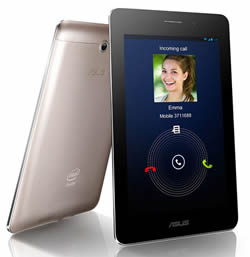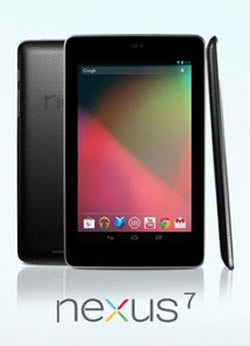Difference between Asus FonePad and Nexus 7
Key Difference: Asus has announced the launch of newest phablet, the Asus Fonepad. The Fonepad is a 7-inch Android tablet that allows users to also make phone calls by placing the device on their ear. The phablet sports a 7-inch IPS LED backlit touch screen that allowed multitouch capability for up to 10 people. The screen has a resolution of 1280 x 800, which provides approximately 216 ppi density, a decent enough resolution. The Nexus 7 is a tablet computer running Android 4.1 (also named Jelly Bean) operating system. It was developed in collaboration with Asus.
Tablets are mainly used for multimedia, watching videos, reading e-books, and surfing the internet. They feature a full virtual keyboard which is useful for online chatting, social networking and sending emails. Tablets also tend to have dual cameras, which can be used to take pictures, while the front facing camera can be used for video chatting and video calling. Basically, tablets are like a mini computer. They are able to perform most tasks that one uses a laptop for, such as surf the net, take pictures, chat with friends, send and receive emails, as well as use it as an e-Book reader. One can also use a tablet for basic computing functions, watching videos and listening to MP3 songs on the internet. Also, tablets are much more portable and lightweight than most laptops, notebooks or netbooks.
 Asus has announced the launch of newest phablet, the Asus Fonepad. The company states that the purpose of launching this phone is to bridge the gap between the phone and the tablet, eliminating the need for the carrying to separate devices. The Asus Fonepad is practically a tablet that has phone call making capabilities. The Fonepad is a 7-inch Android tablet that allows users to also make phone calls by placing the device on their ear. Some people may find it silly to place such a huge device on their ear to make calls; for those people the tablet does allow connectivity with a Bluetooth device.
Asus has announced the launch of newest phablet, the Asus Fonepad. The company states that the purpose of launching this phone is to bridge the gap between the phone and the tablet, eliminating the need for the carrying to separate devices. The Asus Fonepad is practically a tablet that has phone call making capabilities. The Fonepad is a 7-inch Android tablet that allows users to also make phone calls by placing the device on their ear. Some people may find it silly to place such a huge device on their ear to make calls; for those people the tablet does allow connectivity with a Bluetooth device.
The Asus Fonepad has borrowed a bunch of features from the Nexus 7, which was also created under Google and Asus collaboration. The weight, dimension and the display are all similar to the Nexus 7; however, the company has replaced the back. The plastic-leather back of the Nexus 7 has been replaced with a slick, steel casing. The device is available in titanium gray and champagne gold colors. The phablet sports a 7-inch IPS LED backlit touch screen that allowed multitouch capability for up to 10 people. The screen has a resolution of 1280 x 800, which provides approximately 216 ppi density, a decent enough resolution. Under the hood, the phablet runs on 1.2 GHz single-core Intel Atom processor, making it pretty fast for multi-tasking, along with playing some high-res games. The device has 1 GB RAM.
There will be two versions of the tablet, one for Europe, the other for Asia. The launch regarding rest of the World has yet to be revealed. The European variant will have 16 GB internal storage capacity, with no rear camera. However, the Asian variant will 8 GB internal storage capacity and will house a 3.2 MP rear camera. Both the variants will house 1.2 MP front camera for video conferencing. The phablet will not support 4G capabilities. The phablet will be available with preloaded Android v4.1 Jelly Bean, with no announcements yet regarding if it is upgradeable to the newest version. The internal storage capacity can expanded up to 32 GB using a MicroSD. One of the most prominent features of the phablet is the massive battery that has been mounted on the device. The non-removable Li-Ion 4270 mAh battery allows the phone to support 32.5 hours of talktime on 3G and 751 hours of standby time. There is no proper release date for the phone, with the expected release to be around April or May 2013.

Among the number of various companies launching phones based on Google’s Android, Google has also launched its own line of smartphones based on Android, called the Google Nexus. Each device in the Nexus line is produced via collaboration between Google and a leading original equipment manufacturer (OEM) partner. The Nexus devices in general have an advantage over other devices in that the Android in the Nexus devices is pure. I.e. the Android does not have any manufacturer or wireless carrier modifications to it, such as a custom graphical user interface. The Android also has an unlockable bootloader to allow further development and end-user modification, all of which is usually blocked on other Android smartphones.
The Nexus 7 is a 7-inch tablet computer running Android 4.1 (named Jelly Bean) operating system. It was developed in collaboration with Asus. It was the first tablet in the Google Nexus series and features a 7-inch (180 mm) display, an Nvidia Tegra 3 quad-core chip, 1 GB of RAM, and 8, 16 or 32 GB of internal storage. The 8 and 16 GB models were Wi-Fi only, and the 8 GB was eventually discontinued. The 32 GB models are both Wi-Fi and 3G compatible. The Nexus 7 was marketed effectively as an entertainment device. The tablet has been designed with gaming purpose in mind and has received high resolution display and various sensors to make it the ultimate gaming tablet. The tablets has dropped the rear primary cameras in the tablet and instead focus on place a 1-2 MP front-facing camera for video chatting purposes. The company has also eliminated the Camera app, so users will have to download an app from third-party developers from Google Play. According to Techradar, the images from the camera were a little grainy, but video calling was seamless, with no lag during calls. The low price of the Nexus 7 makes it a good and cheap companion. The 32 GB is available for USD 199 from the website.
The information for the detailed table about the two phones has been taken from the Asus website, trustedreviews.com, pcworld.idg.com.au, Google website and GSMArena.com.
|
|
Asus Fonepad |
Nexus 7 |
|
Launch Date |
Expected April 2013 |
June 27, 2012 |
|
Company |
Asus |
Google; designed in collaboration with and manufactured by Asus. |
|
Size |
196.4 x 120.1 x 10.4 mm |
198.5 x 120 x 10.5 mm (7.81 x 4.72 x 0.41 in) |
|
Display |
7" LED Backlight WXGA IPS Panel touch screen |
LED-backlit IPS LCD capacitive touchscreen, 16M colors |
|
Screen |
1280x800 (~216 ppi pixel density) |
800 x 1280 pixels, 7.0 inches (~216 ppi pixel density) |
|
Protection |
N/A |
Corning Glass |
|
Weight |
340 g |
340g (11.99 oz) |
|
2G Network |
GSM 850 / 900 / 1800 / 1900 |
GSM : 850/900/1800/1900 |
|
3G Network |
WCDMA: 850/900/1900/2100 HSDPA 850 / 900 / 1900 / 2100 |
WCDMA : 850/900/2100 |
|
4G Network |
N/A |
N/A |
|
GUI |
Asus UI |
Pure Android |
|
CPU speed |
1.2 GHz Single-core Intel Atom |
Quad-core 1.2 GHz Cortex-A9 |
|
GPU |
PowerVR SGX540 |
ULP GeForce |
|
OS |
Android OS v4.1 (Jelly Bean) |
Android OS, v4.1 (Jelly Bean), upgradable to v4.2.1 (Jelly Bean) |
|
Chipset |
Intel Atom Z2420 |
Nvidia Tegra 3 |
|
RAM |
1 GB |
1 GB RAM |
|
SIM Size |
microSIM |
Micro-SIM for 3G model |
|
Internal Memory |
8/16 GB |
16/32 GB storage |
|
Expandable Memory |
Up to 32 GB |
None |
|
Sensors |
GPS & Glonass,G-Sensor, E-compass, Proximity, Ambient Light Sensor |
G-Sensor, Light Sensor, Gyroscope, E-compass, GPS, NFC, Hall Sensor |
|
Connectivity |
GSM, HSDPA, WCDMA, Bluetooth, USB, WLAN802.11 |
Wi-Fi 802.11 b/g/n Bluetooth NFC (Android Beam) 32GB + Mobile data version only: Unlocked GSM/UMTS/HSPA+
|
|
Data |
GPRS, EDGE, WLAN, Bluetooth, USB |
WiFi, NFC, USB GPRS, EDGE for 32GB + Mobile data version only |
|
Speed |
HSDPA 21 Mbps, HSUPA 5.76 Mbps |
HSPA+ 21 Mbps |
|
WLAN |
WLAN802.11 b/g/n |
Wi-Fi 802.11 b/g/n |
|
Bluetooth |
Bluetooth V3.0 |
Bluetooth V3.0 |
|
USB |
microUSB v2.0 |
Micro-USB |
|
Primary Camera |
3.2 MP autofocus camera |
1.2 MP |
|
Secondary Camera |
1.2 MP |
None |
|
Video |
720p |
720p |
|
Camera Features |
Autofocus |
Video-calling |
|
Sound Enhancement |
Active noise cancellation with dedicated mic; Asus Sonice Master audio technology with MaxxAudio 3 by Waves |
None |
|
Audio supported formats |
MP3/WAV/eAAC+ player |
MP3/WAV/eAAC+/WMA player |
|
Video supported formats |
MP4/H.264/H.263 player |
MP4/H.264 player |
|
Battery Capacity |
Non-removable Li-Ion 4270 mAh battery (16 Wh) |
Non-removable Li-Ion 4325 mAh battery |
|
Talktime |
3G: 32.5 hours |
- |
|
Standby Time |
3G: 751 hours |
- |
|
Available Colors |
Titanium Gray, Champagne Gold |
Black |
|
Messaging |
SMS(threaded view), MMS, Email, Push Email, IM |
Email, Push Email, IM, RSS |
|
Browser |
HTML5 |
HTML5 |
|
Radio |
No |
No |
|
GPS |
GPS, A-GPS, Glonass |
Yes |
|
Java |
Yes, via Java MIDP emulator |
None |
|
Additional Features |
|
|
Image Courtesy: asus.com, androidheadlines.com









Add new comment